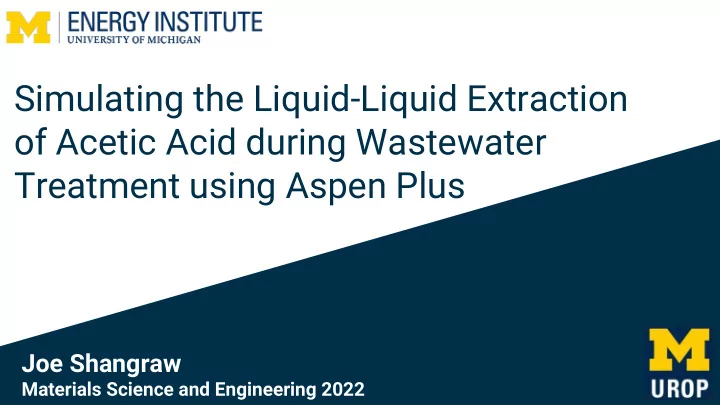

Simulating the Liquid-Liquid Extraction of Acetic Acid during Wastewater Treatment using Aspen Plus Joe Shangraw Materials Science and Engineering 2022
Background ● Wastewater treatment makes up around 20-40% of many local government energy budgets ● 3-4% of all energy consumption is for water treatment, totalling over 45 million tons of GHG emissions (EPA) ● This creates the demand for an energy efficient method of extracting high value products from https://www.tpomag.com/online_exclusives/2019/01/wastewat er-treatment-plants-could-become-sustainable-biorefineries waste
The Big Picture ● The Department of Energy is sponsoring projects at several labs and universities across the country ● The goal is to develop a system to convert food waste and sewage into valuable volatile fatty acids (VFAs) Pretreatment of Sewage Converting waste Extraction of VFAs and Food Waste into VFAs from aqueous stream
Former Research at U of M Developed CLEANS extraction method: ● Liquid-liquid extraction of carboxylic acids ● Assisted by novel, oleophobic membrane Diagram of CLEANS process (made by David Speer)
UROP Summer Project Model the CLEANS method using the Aspen Plus Chemical Process Simulator ● Observe how solvent choice and concentrations affect the rate of extraction ● Focus on reaction between acetic acid and the extractant Benefits of an accurate simulation ● Quicker way to screen potential solvents and extractants for optimization of concentrations
Acetic Acid and Extractant Reaction Acetic Acid + Extractant complex (Tamada and King 1990) Trioctylamine (extractant)
Aspen Plus Simulation Stream summary of both Molecule builder for inputs and outputs after Example Flowsheet of chemicals not in the Aspen running the simulation Extraction Reactor Database
Validating Simulation against Previous Research Extraction of acetic acid with trioctylamine Extraction of acetic acid with TOA in (TOA) in chloroform (Wardell and King, 1978) toluene (Sprakel and Schuur, 2019)
Published experiments Simulations Chloroform (Active solvent) 0.2 M Toluene (Inactive solvent) 0.17M
Errors in Results ● Aspen Plus cannot always predict properties of molecules that are not in the database, especially when they have charges ● The interactions between the molecules and the solvents are more complex than what can be entered for an Aspen reactor, especially with active solvents such as chloroform.
Future Work ● Explore other simulation software with different mechanisms ○ Could provide more accurate results than Aspen Plus ● Return to the lab to run the extraction in person ● Continue to review previous literature to choose the most effective solvents and extractants
References 1. Environmental Protection Agency (2015). Energy Efficiency in Water and Wastewater Facilities. Retrieved from https://www.epa.gov/sites/production/files/2015-08/documents/wastewater-guide.pdf 2. Tamada, J. A., & King, C. J. (1990). Extraction of Carboxylic Acids with Amine Extractants 2: Chemical Interactions and Interpretation of Data. Ind. Eng. Chem. Res., 29, 1327-1333 3. Wardell, J. M.; King, C. J. (1978). Solvent equilibria for extraction of carboxylic acids from water. J. Chem. Eng. Data, 23(2), 144-148. 4. Sprakel, L. M. J., & Schuur, B. (2019). Solvent developments for liquid-liquid extraction of carboxylic acids in perspective. Separation and purification technology, 211, 935-957.
Recommend
More recommend